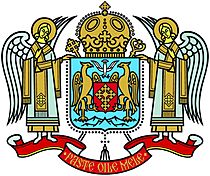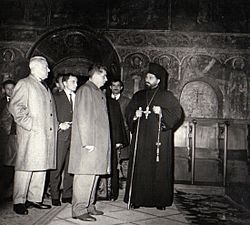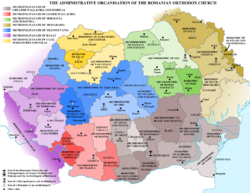Romanian Orthodox Church facts for kids
Quick facts for kids Romanian Orthodox Church |
|
|---|---|
| Biserica Ortodoxă Română | |

Coat of arms
|
|
| Abbreviation | ROC BOR |
| Type | Autocephaly |
| Classification | Christian |
| Orientation | Eastern Orthodox |
| Scripture | Septuagint, New Testament |
| Theology | Eastern Orthodox theology |
| Polity | Episcopal |
| Primate | Daniel, Patriarch of All Romania |
| Bishops | 58 |
| Priests | 15,068 |
| Distinct fellowships | Ukrainian Orthodox Vicariate, Army of the Lord |
| Parishes | 15,717 |
| Monastics | 2,810 men, and 4,795 women |
| Monasteries | 359 |
| Associations | Eastern Orthodox Church |
| Language | Romanian |
| Liturgy | Byzantine Rite |
| Headquarters | Dealul Mitropoliei, Bucharest |
| Territory | Romania Moldova |
| Possessions | Serbia Hungary Western and Southern Europe; Germany, Central and Northern Europe; Americas; Australia, New Zealand and Japan |
| Founder | (as Metropolis of Wallachia) Iachint of Vicina, Nicholas Alexander Miron Cristea, Ferdinand I |
| Independence | 1865 |
| Recognition | 25 April 1885 (Autocephalous metropolis) 1925 (Autocephalous Patriarchate) |
| Absorbed | Romanian Greek Catholic Church (1948) |
| Separations | Old Calendarist Romanian Orthodox Church (1925) Evangelical Church of Romania (1927) Romanian Greek Catholic Church (1990) |
| Members | 16,367,267 in Romania; 720,000 in Moldova 11,203 in United States |
| Publications | Ziarul Lumina |
The Romanian Orthodox Church (ROC), also called the Romanian Patriarchate, is an autocephalous (self-governing) Eastern Orthodox church. It is in full agreement with other Eastern Orthodox Christian churches. It is one of the nine main church leaders (called patriarchates) in the Eastern Orthodox Church.
Since 1925, the church's main leader, known as the Primate, has been called the Patriarch. This church covers areas in Romania and Moldova. It also has church groups for Romanians living in nearby Ukraine, Serbia, and Hungary. There are also groups for Romanians living far away in Central and Western Europe, North America, and Oceania. It is the only self-governing Eastern Orthodox church that uses a Romance language (Romanian) for its church services.
Most people in Romania (about 16.3 million, or 85.9%) belong to the Romanian Orthodox Church. Also, about 720,000 people in Moldova are members. Members sometimes call their beliefs Dreapta credință, which means "right belief" or "true faith."
Contents
History of the Romanian Orthodox Church
The Orthodox Church in the area of modern Romania was once part of the Ecumenical Patriarchate of Constantinople. This changed in 1865. The churches in the Romanian regions of Moldavia and Wallachia decided to become independent. They chose Nifon Rusailă as their first Romanian leader.
In 1863, Prince Alexandru Ioan Cuza took over many church lands. This was met with strong disagreement from the Greek church leaders in Constantinople. In 1865, Prince Cuza passed a law that made the church in these regions completely independent.
In 1872, the main church groups in Moldavia and Wallachia joined together. This formed the Romanian Orthodox Church.
Becoming a Patriarchate
After Romania gained international recognition as an independent country in 1878, the church worked to be recognized as self-governing. In 1885, the Ecumenical Patriarch Joachim IV officially recognized the Romanian church as an independent (autocephalous) group. In 1925, it was raised to the rank of a Patriarchate.
At the end of the 1800s, religious education in Romania was still developing. Priests learned many practical subjects like hygiene and accounting. They also focused on church music, church law, and history.
After World War I, Romania grew much larger. The Romanian Orthodox Church had to reorganize to include new church groups. This was a big challenge. The church needed clear rules for everyone. It also had to manage money from the government for priests in new areas. Laws were made to help the church work with the state.
Young theologians like Nichifor Crainic and Dumitru Stăniloae studied abroad. They became very important when they returned. They helped shape how religious schools taught. Many Romanian Orthodox thinkers of this time supported nationalism. Their writings often showed these nationalistic ideas.
The Church and Politics in the 1930s
In the 1930s, Nazi Germany's ideas about nationalism and race began to influence Romania. These ideas mixed with existing nationalist views within the Romanian Orthodox Church. This became clear in the writings of some theologians.
In 1937, the deaths of two members of the Iron Guard (a far-right group) led to large public events. Many Orthodox priests took part in these events. Church leaders also spoke out against Freemasonry. They said the church had the right to support political parties based on moral principles.
In 1937, the government passed laws that took away citizenship from many Jewish people. The head of the Romanian Orthodox Church, Patriarch Miron Cristea, made a speech. He described Jewish people in a very negative way. Many Orthodox priests were active in far-right politics. In the 1937 elections, 33 out of 103 Iron Guard candidates were Orthodox priests.
Patriarch Miron Cristea became prime minister in February 1938. He continued policies that limited the rights of Jewish people. He also supported more extreme measures. The church newspaper helped spread these ideas. Patriarch Cristea died in March 1939. After his death, the church leaders voted to keep rules that stopped Jewish people who were not Romanian citizens from being baptized.
World War II and the Church
When King Carol II left power in 1940, a pro-German government took over. Patriarch Nicodim Munteanu was careful in his reaction. In January 1941, the Iron Guard tried to take full control in a violent uprising. This failed, and many Orthodox priests who took part were arrested.
Some priests were involved in violent acts during this time. For example, students and staff at a theological school forced Jewish people to hand over valuables. Monks from a monastery blew up a synagogue.
After the uprising was stopped, the church leaders quickly condemned the Iron Guard. They said it had tried to harm the state. However, many priests who had been involved were protected by their bishops. They continued working in villages.
During World War II, Romania joined the Axis side. Some Orthodox theologians spread ideas that linked Jewish people with communism. This idea became common in church newspapers. Patriarch Nicodim himself wrote an article in 1942 about the danger of "domestic enemies," mostly identifying them as Jewish.
The Romanian Orthodox Church also set up a mission in Transnistria, an area occupied by Romania. Many missionaries there had ties to the Iron Guard. There were many reports of priests taking part in or benefiting from the mistreatment of Jewish people.
However, there were some exceptions. Two high-ranking bishops, Tit Simedrea and Nicolae Bălan, helped Jewish people. Priest Gheorghe Petre was recognized for saving Jews.
After Romania switched sides in the war in August 1944, the church faced a new challenge. It had long been against the Soviet Union and communism. Patriarch Nicodim quickly wrote a letter. He blamed Germany for the war and praised the Soviet Union. He said the church had always supported democracy.
In 1945, the church newspaper published articles that blamed Germany for the war's horrors. They claimed the Orthodox Church had always promoted democracy. They also praised the Romanian Army for joining Soviet forces. The church asked its members to support the new government.
The Church During Communism

Romania became a communist state in 1947. The communist government allowed the Orthodox Church to exist, but it controlled it very closely. The government tried to remove church leaders who did not agree with its policies. Many bishops were arrested or forced to retire.
In 1948, a new law gave the state control over who could be chosen as bishops. The government also gave the Romanian Orthodox Church control over many church buildings and properties that belonged to another church group, the Romanian Greek-Catholic Church, which was outlawed. The government also paid the salaries of priests and helped publish religious books.
The communist government closed many monasteries between 1958 and 1962. Thousands of monks were forced to take regular jobs. Many clergy and church workers were arrested. During this time, Patriarch Justinian Marina was careful to support the government in his public statements.
The church's situation began to get better in 1962. This was when Romania started to follow its own foreign policy, separate from the Soviet Union. The government saw the Romanian Orthodox Church as a partner because of its strong connection to Romanian culture and history.
The church then began to recover. By 1975, it had about 12,000 priests. It also published several high-quality religious magazines. Orthodox clergy supported the government's foreign policy. They did not criticize domestic policies. They also supported Romania's stance against the Soviets and Hungarians.
However, church leaders mostly stayed silent when many historic churches in Bucharest were destroyed in the 1980s. One notable person who spoke out was Gheorghe Calciu-Dumitreasa. He was imprisoned and later expelled from Romania for criticizing the government.
During this time, Patriarch Justinian developed a new idea called "Social Apostolate." This idea said that the church should support the government and serve it. This led to some disagreements within the church.
After the Fall of Communism
After the Romanian Revolution in 1989, the church became much freer from state control. However, the government still oversees some parts of the church's property, money, and management. The state provides money to the church based on how many members it has. This includes salaries for priests and other church workers. It also helps pay for building and repairing churches.
Since 1989, leaders of the Greek-Catholic Church have said that their community is facing challenges. They claim their churches are being destroyed by representatives of the Eastern Orthodox Church. They say Romanian authorities support these actions.
In 2018, the church openly supported a public vote to ban same-sex marriage. The church believes that homosexuality is a sin and unnatural.
The Church in Moldova
The Romanian Orthodox Church also has authority over some believers in Moldova. These members belong to the Metropolis of Bessarabia. Most Moldovans belong to a different church group under the Moscow Patriarchate.
In 2001, the Metropolis of Bessarabia won an important legal case against the Government of Moldova. This means it is now recognized as the rightful successor to an older church group that existed from 1927 to 1944.
Since the start of the Russian invasion of Ukraine, many church groups in Moldova have switched from the Moscow-controlled church to the Metropolis of Bessarabia. This has sometimes caused strong debates.
Organization and Leadership
The Romanian Orthodox Church is organized as the Romanian Patriarchate. The highest authority is the Holy Synod.
There are ten main church regions (called Metropolitanates). There are also twenty archbishoprics and twenty-three bishoprics in total. Four metropolitans and nine bishops serve Romanians living outside Romania.
The church has over 12,000 altar servers in churches, monasteries, and social centers. There are almost 400 monasteries in Romania. These are home to about 3,500 monks and 5,000 nuns.
As of 2004, Romania has fifteen religious universities. More than 10,000 students study there. Some students from other countries receive scholarships. There are over 14,500 churches for Romanian Orthodox believers. In 2002, almost 1,000 of these were being built or rebuilt.
Current Leadership
The current Patriarch is His Beatitude Daniel. He is the Archbishop of Bucharest and Metropolitan of Muntenia and Dobrudja. He also holds the special title of Locum Tenens of Caesarea in Cappadocia. This title was given in 1776 to the leader of the church in Wallachia, which was the earlier form of the Romanian Patriarchate.
Other important leaders include:
- Teofan, Metropolitan of Moldavia and Bukovina
- Laurențiu, Metropolitan of Transylvania
- Andrei, Metropolitan of Cluj, Maramureș and Sălaj
- Irineu, Metropolitan of Oltenia
- Ioan, Metropolitan of Banat
- Petru, Metropolitan of Bessarabia
- Iosif, Metropolitan of Western and Southern Europe
- Serafim, Metropolitan of Germany and Central Europe
- Nicolae, Metropolitan of the Americas
Notable Theologians
Dumitru Stăniloae (1903–1993) is seen as one of the most important Orthodox theologians of the 20th century. He wrote many books on Eastern Christian systematic theology. He also worked for 45 years on the Romanian Philokalia. This is a large collection of texts on Orthodox spirituality that he translated from Greek.
Archimandrite Cleopa Ilie (1912–1998) was a respected elder from the Sihăstria Monastery. He is known as a key figure in modern Romanian Orthodox monastic spirituality.
Metropolitan Bartolomeu Anania (1921–2011) was the Metropolitan of Cluj, Alba, Crișana, and Maramureș from 1993 until his death.
List of Patriarchs
- Miron (1925–1939)
- Nicodim (1939–1948)
- Justinian (1948–1977)
- Iustin (1977–1986)
- Teoctist (1986–2007)
- Daniel (since 2007)
Special Commemorative Years
Patriarch Daniel started a tradition of declaring special "jubilee" and "commemorative" years. These years focus on specific themes important to the Church and society. During these years, there are special meetings, conferences, and other church activities.
Some recent themes include:
- 2020 – Focused on helping parents and children, and remembering Romanian Orthodox people who gave to charity.
- 2021 – Focused on caring for Romanians living abroad and remembering those who have passed away.
- 2022 – Focused on the importance of prayer in church and in a Christian's life.
- 2023 – Focused on caring for the elderly and remembering church hymn writers and singers.
- 2024 – Focused on caring for the sick and remembering holy healers who did not charge for their services.
- 2025 – Will be a special year celebrating 100 years since the Romanian Patriarchate was established. It will also remember Romanian Orthodox people who stood strong during the 20th century.
See also
 In Spanish: Iglesia ortodoxa rumana para niños
In Spanish: Iglesia ortodoxa rumana para niños
- Romanian People’s Salvation Cathedral
- List of Romanian Orthodox monasteries
- Romanian Orthodox icons
- Religion in Romania


